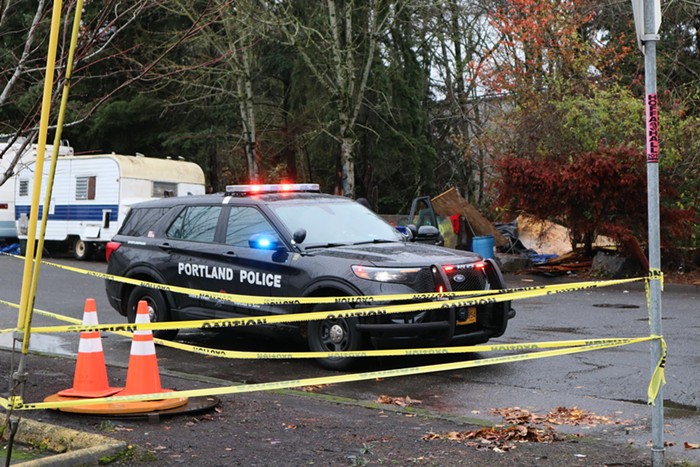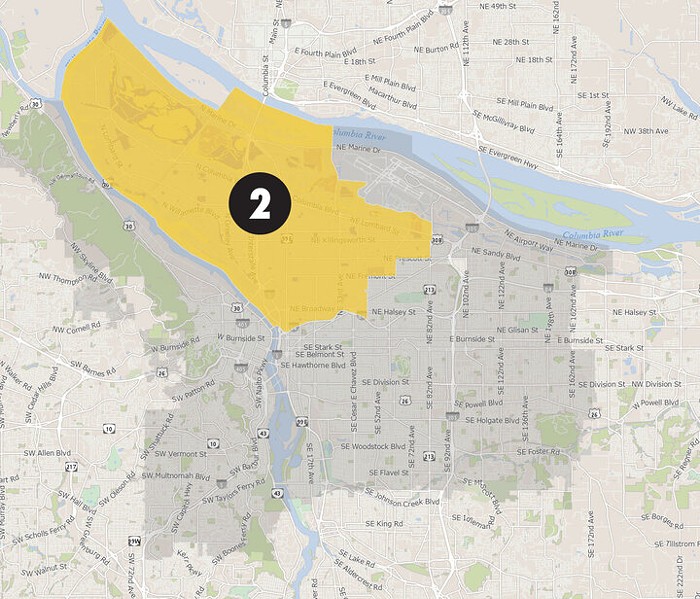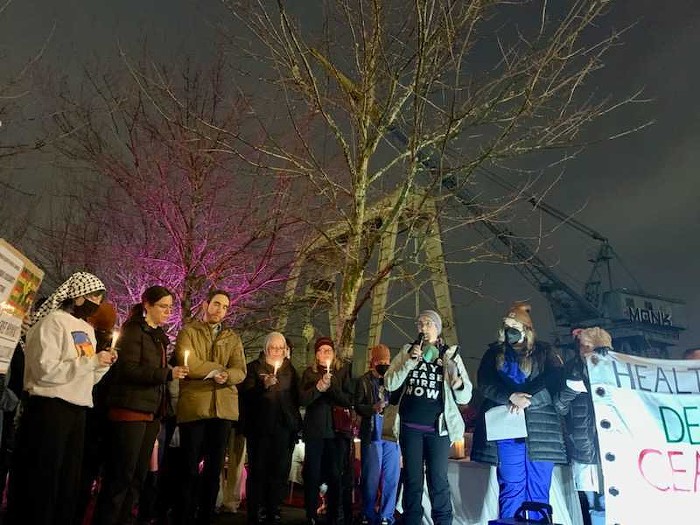
There are several reasons why Portland's record-breaking heatwave in June might have been so deadly. According to a report published Wednesday by Multnomah County, officials believe the heatwave caused such devastation due to residents' general lack of preparedness for summer weather and a reluctance to visit crowded indoor cooling shelters during a pandemic.
These are just some of the factors that the county identified in its lengthy report, which used feedback from first responders, community organizations, mutual aid groups, and volunteer groups who assisted with the heatwave response to explain what went right and what went wrong during the late June heatwave which killed 62 Multnomah County residents. The report also offers suggestions on how the county could improve its future response to extreme heat waves.
June2021_Heat_Event-Preliminary_Findings-08_21.pdf
Prior to the five-day heatwave beginning June 25, the highest temperature ever recorded in Multnomah County was 107 degrees. That record was set in 1965, and recorded again in 1981. At the end of June, the county broke that record for three consecutive days, recording highs of 108, 112, and 116 degrees. According to the county report, more people died from the June heatwave in Multnomah County than the state of Oregon’s heat deaths over the past 20 years.
The report notes this death toll may have been so high because the heatwave took place early in summer, before most people had acclimated to high temperatures. While heat can always be deadly, the report says “the human body can acclimate to hotter temperatures, up to a point, over time,” and hot weather early in the summer tends to be more deadly.
Additionally, because the heatwave took place in a region of the country where people lack experience with extreme heat, many people did not know how to protect themselves.
“Because people may not have experienced such temperatures before,” the report reads, “people may not have understood the severity of the threat and therefore may not have made behavior changes to adapt to the temperatures (e.g., close blinds, use air conditioning, seek out spaces with air conditioning).”

The report also cites issues like cooling centers being limited to three locations, a lack of translators available to translate updated cooling resource information, people not fully understanding the dangers of the heat, and other communication issues with the public and internally, like 2-1-1—the primary hotline for all cooling center information—becoming unavailable to hundreds of callers throughout the weekend.
During the June heatwave, 2-1-1 staff did not update its directory to include an option for heatwave resources until Sunday afternoon, three days after the heatwave officially began. While 2-1-1 provides 24/7 service for Multnomah County callers during extreme weather, the hotline led many callers to a recorded message incorrectly claiming the hotline was closed through the weekend—some of the hottest days of the heatwave. The report also says 2-1-1 dropped more than 750 calls throughout the heatwave, kept callers waiting for long periods, and occasionally gave out inaccurate and outdated information.
Following the heatwave, the county made six immediate changes to its extreme heat response protocol that were in place for the two subsequent heatwaves in July and August. Most noticeably, Multnomah County expanded its communication outreach, activating the public alert system to call hundreds of thousands of county residents who either signed up for alerts, or have a landline or mobile number connected to a utility bill. The county also expanded the number of cooling shelters, provided additional training and coaching to volunteers for cooling center management, updated its protocols to allow the county’s emergency response office to activate cooling centers at the first hint of extreme heat, formalized its internal communication system, and created specific emergency response standards for 2-1-1 to solve their directory issue.
With those changes in place, Multnomah County Emergency Management Division Chief of Operations Alice Busch says the county and its partners are heading in the right direction for responding to heatwaves.
“For this most recent heatwave, we were able to incorporate almost all of those shorter and midterm improvement areas, including creating a unified command structure with the City of Portland and pre-event trainings for people who had never worked in cooling shelters to better prepare them for that work,” Busch said during a press conference about the report Wednesday.
The county still has a long list of changes it needs to make to improve its future heatwave responses, most of which aim to expand or strengthen the county’s current structure.
The county will continue to increase its pool of potential cooling centers and shelters, seeking partnership with Metro, school districts, and other institutions to identify facilities that are well suited to serve as cooling spaces. Those facilities will be determined by logistics like space and ventilation systems, but also by geographic location as it relates to most at-risk populations and other equity-based requirements.
In tandem with expanding cooling centers, the county plans to increase its staffing capacity at cooling center locations. The county currently leans heavily on volunteers—many of whom are county and city employees—to staff emergency shelters.
“None of this work is going to be accomplished by the county alone, by county staff, or even by city staff and nor should it be,” Busch said, citing the community-based organizations and Neighborhood Emergency Teams that also regularly assist during extreme weather events. “All disasters are local, and the people that live in the communities that we serve are some of the best people to work with their neighbors and friends who are impacted by the different disasters.”
Some county employees have previously expressed concern about volunteering at emergency shelters during the pandemic. During February’s ice storm, county employees were called to volunteer at warming centers, but several of them were worried about the public health risks, going as far as to contact the county auditor with fears about potential consequences over what would happen if they refused to volunteer.
According to the report, the county will begin to incorporate expectations of an employee’s emergency response role into job profiles and expand training for county staff and volunteers alike.
“There's always more work that needs to be done than we ever seem to have the capacity to provide,” Busch said. “We are constantly building our bench strength, and that means looking outside of just the city and county and public agencies to provide the work.”
The report also notes that not everyone may feel comfortable going to cooling centers, meaning that the county needs to find ways to get cooling resources to people in their homes. The heatwave death report the county released in July found that victims of June’s heatwave chose not to seek out cooling centers or ask friends who had air conditioning for help because they didn’t want to impose on others.
Donna Crawford, the sister of heatwave victim Lyle Crawford who died alone in his apartment with only a single box fan in June, told county officials she believes her brother may have sought out a cooling space if someone had knocked on his door and told him the risks face-to-face, as reported in the heatwave deaths report.
The county will explore expanding door-to-door outreach, working with community-based organizations to develop a program of bilingual communicators who can assist in the effort.
More short-term improvements include developing specific heat-related policy with TriMet to ensure people are able to get rides to cooling spaces even if they can’t pay fare, and increasing communication efforts across various platforms and languages.
The report also stresses the need for the county and other policy-makers to address climate change. According to World Weather Attribution, if current greenhouse gas emissions continue, an extreme heatwave like the June event could happen every five to 10 years by 2040. While the county and city can open more cooling centers and pass out more water bottles, the response can only mitigate the immediate harm of each individual heatwave—the real solution is tackling the root cause of climate change.
The report underscores the county and city’s existing climate action goals, including reducing carbon emissions to 40 percent below 1990 levels by 2030 and 80 percent below 1990 levels by 2050. Multnomah County’s current emissions are 19 percent below 1990 levels, but transportation emissions have been increasing in recent years.
The county plans to pursue “policies to accelerate the decarbonization of Multnomah County’s electricity supply,” advocate for state-level policy around green building codes and transitioning away from fossil fuels, increase the tree canopy throughout the area and particularly in the county’s eastern areas, and fund low-income household weatherization. Multnomah County Chair Deborah Kafoury pointed to the Portland Clean Energy Fund (PCEF) as an example of a program that could assist with weatherizing low-income homes.
“I'm proud to be part of a team that really leans into learning, and I'm proud to be part of an organization that encourages the kind of honest dialogue about how we can improve that we have been engaging in,” Busch said about the county’s work following the June heatwave.
The county is still working on a more detailed report on the June heatwave, which will include longer term solutions that will take more time to carry out. That report is expected by the end of the year.



















